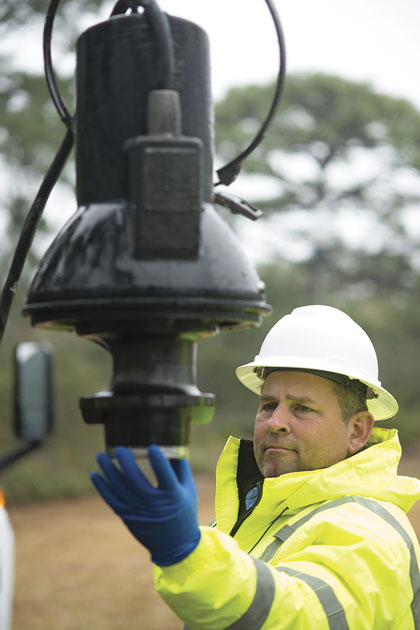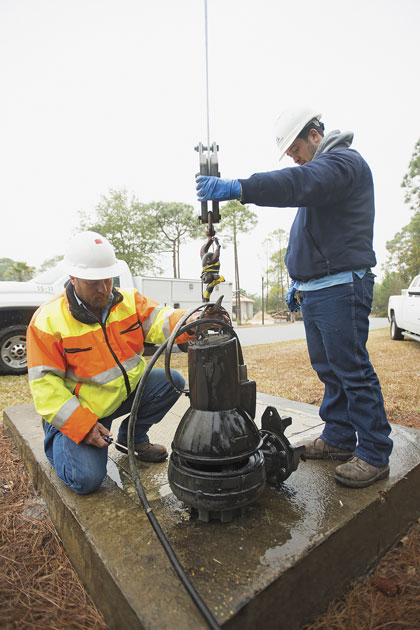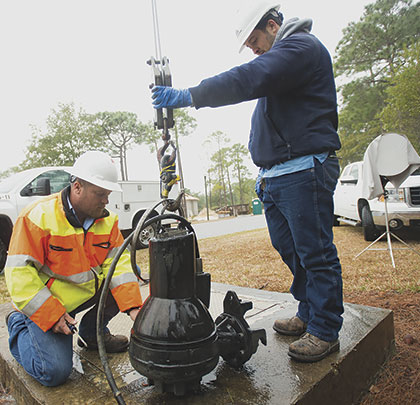Last month, we began our examination of how conventional wastewater pumps can disappoint under demanding circumstances with a closer look at a retrofit project in DeFuniak Springs, Florida, a small city an hour’s drive east of Pensacola. In part 2, we continue by walking through a similar pump failure that took place about six hours across the Panhandle, where a private, non-profit utility serving Destin, Florida, and parts of Okaloosa County was struggling with extended run times and pump fouling.

Featured Image: Clogged wastewater lift stations can plague municipalities, such as Florida-based Destin Water Users, Inc., a private, non-profit utility serving Destin and parts of Okaloosa County. Utility engineers solved the problem by installing the Grundfos SL1 wastewater pump with the S-tube impeller, which ensures that solids up to 4 inches in diameter pass freely.
HANDLING INCREASED FLOW
At Destin Water Users, Inc. (DWU), the utility was plagued with recurring clogs at lift station E-03, a duplex pump station with two 5-horsepower pumps serving about 100 homes in the Kelly Plantation area. This station faced many of the same challenges as the one at Oakdale, with less frequent jams occurring once or twice a week.
“The pumps were clogging with everything from rags to construction debris,” recalls lift station superintendent Rick Martin, who notes that run times had increased to nearly six minutes, instead of the expected five minutes. “We needed something better. Brian Widman, a principal with Gilbert Pump and Mechanical, suggested a Grundfos pump, so we decided to give it a go.”
Unlike the apartment complex’s lift station where there were an unusually high volume of solids, the pumping challenges for the Destin utility was to reduce pump run time and less frequent clogging.
Widman determined that the best hydraulic fit for this application would be the Grundfos SL1 with the S-tube impeller. The S-tube is an innovative channel impeller that ensures trouble-free operation by offering greater hydraulic efficiencies than any other type of wastewater impeller without compromising free passage. The impeller has no edges, dead zones, or cutting functions that, in other pump types, can get worn, and fail over time.

Tony Kent examines a new Grundfos SL1 wastewater pump.
Due to the SL1 pump’s high rate of efficiency, it was able to meet the utility’s high flow rate while still reducing pump run time. Because the duplex lift station had experienced so many clogs, Martin decided to replace just one pump at first, and to give it a three-month trial. The immediate payoff was a runtime of just two minutes—a third of the old pump—and when the SL1 was pulled for inspection, there were no signs of impending clogging.
“The SL1 pump was hitting the design point of 350 gpm at 35 feet of TDH with no debris buildup in the volute,” recalls Widman. “Ironically, during the inspection, the other remaining pump was clogged.”
The test results sold the DWU utility on the SL1 wastewater pump’s solid performance. They replaced the second pump at the E-03 lift station, and purchased two more pumps to retrofit other lift stations in their network. All have been running flawlessly since installation.

Workers Richard Johnson (Left) and Ikaika Moyer with Florida-based Destin Water Users, Inc., a private, non-profit utility examine a new Grundfos SL1 wastewater pump.
LESSONS LEARNED
The SL1 and SLV have only been available in the U.S. for about five years, but success stories like Oakdale and Destin show how they are quickly proving their worth. In fact, Widman reports he’s installed more than 200 of the wastewater pumps to overcome challenging applications.
By offering leading free passage capabilities without compromising efficiencies, the SL1 and SLV line of pumps will continue to be an answer to traditional-style non-clog impellers when heavy solids-handling capabilities are needed.
“When the wipes, rags, trash, and other debris are pumped out of the station by a pump such as the SL1 or SLV, the fats, oils, and grease have nothing to grab on to,” concludes Widman. “The station becomes cleaner, maintenance costs decrease, and consumer flushables and other solids are sent to the treatment plant, where the solids can be processed.”
That has certainly been the case at Oakdale and Destin. Not only have the pumps been clog-free, but there has been less grease buildup in the wet wells, further reducing maintenance costs.
Eliminating wear caused by chronic clogging also means a longer service life. In fact, the flawless operation at Oakdale has made Swift very optimistic. “A pump should run at least twelve years without problems,” she says. “I expect these to last closer to 20.” ◆
For More Information:
Björn Adolfsson is marketing manager, water industry solutions, for Grundfos Pumps Corporation. He can be reached at 913.495.4727 or badolfsson@grundfos.com. Grundfos Pumps Corporation, part of the Grundfos Group, is a global pumps and pumping systems leader serving the residential, commercial-building, and process-industry markets, as well as being a major supplier to the water-supply and water-treatment industries. Founded in 1945 in Bjerringbro, Denmark, The Grundfos Group is a worldwide enterprise that employs more than 18,000 people in 81 countries with North American headquarters in Downers Grove, Illinois. For more information, visit www.grundfos.us.
____________________________________________
MODERN PUMPING TODAY, February 2016
Did you enjoy this article?
Subscribe to the FREE Digital Edition of Modern Pumping Today Magazine!
![]()


